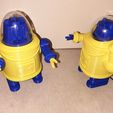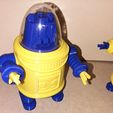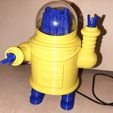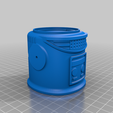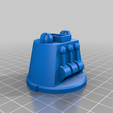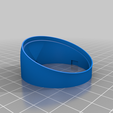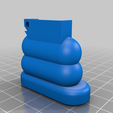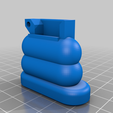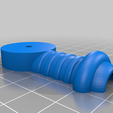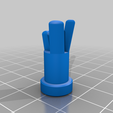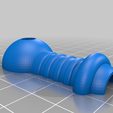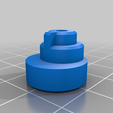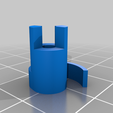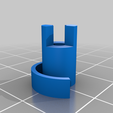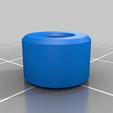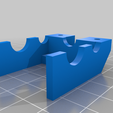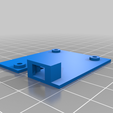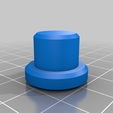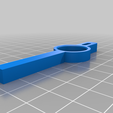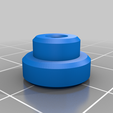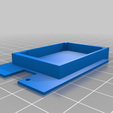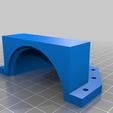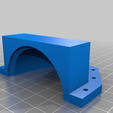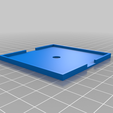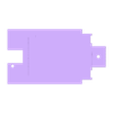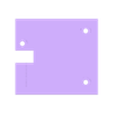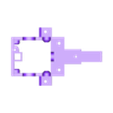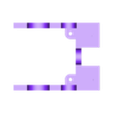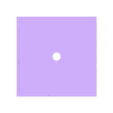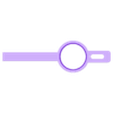Youtube video:
https://youtu.be/-c5GyUUYcsI
This 3d printed project is another remote controlled pin walking toy robot that is driven by a single motor. It can move forward or spin in place. It uses a two way to one way rotation mechanism to accomplish this. It has 2 control options. You can control it with 2 SPDT switches or use the IR control board I designed.The motor is an N20 gear motor. The wired remote version used a 6V 160 RPM motor. The IR controlled version used a 6V 200 RPM motor.The battery for the wired remote version is a 4 AA battery pack. The IR controlled version uses a single cell lipo. The remote control is a universal infrared remote unit set up to transmit 12 bit Sony codes. The ir commands are interpreted by a microcontroller and drive the motor through a L9110s motor driver. For this project the right angle headers for connecting the IR sensor to the board are not use. The IR sensor is connected to the board with a length of 3 conductor wire solderd directly to the board. This is due to limited space.
There are 2 options for the dome. I will include a mold for making a vacuum forming buck of the dome. I know nothing about vacuum forming but was able to make a plaster of paris buck with the mold. Then I used a simple vacuum forming box and shop vac to mold the plastic. A heat gun was used to heat the plastic. There are Youtube videos showing how to make a vacuum former. The other option is a 50mm clear ornamant globe you can buy on Ebay.
There are two versions of the mcu board. One uses an Attiny85 and the other uses a Picaxe 08M2. I used to do a lot with the Picaxe and it's a nice fit for this project. It's Basic language is less intimidating than the Arduino C++ language. It also contains built in commands for reading Sony ir codes. I will include links to the EasyEda schematics and boards for both versions. You can order the boards through JCLPCB, PCBWay, or any place you choose. I got 5 of each board from JCLPCB for a under 20 dollars. You just have to watch which shipping method you pick. The only surface mount component on the boards is the L9110s but it's it can be easily hand soldered. The resistors are all 1/8 Watt. The gerber files for having the boards manufactured will be on the Github for either the Picaxe ar Attiny board.You will need to zip them up to send them to the pcb manufacturer. You can also open the project in EasyEda and get the zip files from there.
You will need some special hardware for the build. The 52 mm brass shafts is cut from 1/8 inch rod but 3MM should work. I used 1/8 inch brass welding rod from a Tractor Supply. The screws are 3MMX12MM button socket head cap machine screws and 2MMX8MM self tapping screws. I got them off Ebay. Some thin double sided tape for mounting the battery. Some foam double sided tape for mounting the control board. Super glue. An 1/8 inch drill. O rings for springs to make the arms poseable. I got the O rings in an O ring kit from Harbor Freight. You may need a JST 2.0 PH 2 male connectors to connect the battery to the controller board if your lipo has a different connector. Some Dupont connecters for connecting the motor to the control board.
The most difficult part of the assembly is the cams, gear, pawl, axle mechanism. I will try to descibe it but you should watch the video if you want to build it.
The 52 MM 1/8 inch brass rod is mounted permanently to the right cam. I pressed it on with a drill press for exact alignment but I've also made one by tapping it in with a hammer. Just be careful to get it straight.
The right_bevel gear_30T and right_gear spacer are mounted permanently to each other by tapping them together with a hammer using the 3D printed arbor.
The left_gear_spacer_cam and left_bevel gear_30T are also joined permanently using the hammer and arbor. They are keyed so the cam location will be aligned to the ratchet on the gear.
You may have to do some adjusting with files and sandpaper if the parts are too tight to fit together. If they are too loose for the press fit you can use super glue. You can also try adjusting slicer settings to get a better fit.
After you get the right bevel gear and left bevel gear assemblies complete you need to drill them out with an 1/8 inch drill so that the brass axle spins freely inside them. I used a cordless drill. Make sure you get the drill started straight. You could also use a drill press.
The left_pawl and right_pawl will probably need to be drilled out for ease of assembly. Try to drill them out just enough to allow them to be slid onto the axle and their positions to be adjusted. The axle will attached to these parts (the pawls) permanently with super glue after they are in their final position. Be careful when holding them to drill. It's easy to break or crack the little fingers on the pawls.
The right and left pawls are glued to the 1/8 inch axle and have to oriented properly to the right cam so the pins stay in phase. Slide the right cam and axle through the right_bevel_gear assembly. The bevel gear should spin freely on the axle without a lot of wobble. Then slide the right pawl onto the axle. Next is the left pawl. The notches on the pawls interlock. The pawls should be 180 degrees apart.If you draw a line through the ends of the pawls the line should be in line with the line printed on the right cam. Glue the pawls to the each other and the axle. After the glue is set if it's a little out of line you can adjust it by holding the axle and turning the cam. Next slide the left wheel bevel gear assembly onto the axle. It should spin freely.
After the glue is set you can put the entire cams-axle-pawl assembly into the frame. The 30T bevel gears need to be in proper orientation when the bevel gear mounted on the motor comes into mesh with them for the robot to walk properly. This is shown in the video.
The N20 motor is positioned in place with the top bevel gear so that everything runs freely. There is a spacer between the motor and the bevel gear. Hook up the motor to a battery box and run it forward and reverse. When the motor is run forward both cams should spin in the same direction ( move the bot forward). When the motor is run in reverse the left cam should run in reverse and the right cam should still run forward ( spin the bot in place ).
After everything looks in time you can mount the frame clamp with 2 3MM X 12MM machine screws. This should lock everything in place. Use a little hot glue to keep the motor in place.
The pins are placed on the cams and M3X12MM screws are run through the slots and into the fram. The pins should slide on the screws an around the cams smoothly. The legs are held on by M3X12MM screws. At this point if you should test it with your switch box and it should walk forward and spin depending on the direction the motor is turning. Make sure it's working properly before going further.
At this point the rest of the assembly is simpler. The brain box is mounted to the frame with a 2MMX8MM sef tapping screw. If you go the IR route You need to solder a 3 conductor wire to the IR sensor and pass it through the hole in the top of the brain box bfore screwing it on. The boards that hold the battery and IR board are held on with 2MMX8MM screws. The battery is held in place with thin double sided scotch tape. The IR board is held in place with foam double sided tape. The switch is held to the battery carrier board with hot glue. If your building the wired version you don't need any of that. Just run the wires from the motor to your switch box.
If you use the vacuum formed dome just super glue it to the body. If you use the ornament globe the cut the tap off the globe and glue it to the round_dome_adaptor. Wait to glue the adaptor to the body until after the body is screwed to the frame. The body and brain box are tabbed together so you may have to adjust the alignment. The adaptor is tabbed to the brain box also.
They arms are made in 2 parts and have to be glued together. Each half has 2 holes for 1.75 MM filament for alignment during gluing. The hands are sandwiched between the arm halfs before gluing.The arms are held to the body by M3X12MM screws. The screws are run through orings to provide a springy feel and make them posable.
3D printing notes:
I printed it at .16MM layer height. There are some sacrificial bridges that have to be trimmed out with a hobby knife. The body has a sacrificial bridge so it would print witout supports. It's only one layer of plastic so it's easy to trim out.The other bridges are just screw holes that can be drilled out.
Any files with an X2 or X3 require 2 or 3 of the parts.
The files right_pawl and left_pawl.stl have to be printed with 100% infill.
Links:
Github Wiki for Picaxe code and pcb files:
https://github.com/Rick-100/Single-motor-3-function-toy-robot-Picxae-08M2-version/wiki
Use the file IR_motor_for_rev.bas for programming the 08M2.
Github Wiki for Attiny85 code and pcb files:
https://github.com/Rick-100/Single-motor-3-function-toy-robot-ATTINY85-version/wiki
Use the file attiny85_sony_ir_basic_pwm.ino or attiny85_sony_ir_basic_pwm.hex for programming the attiny85.
EasyEda Picaxe schematic and board:
https://easyeda.com/Rick100/ir_picaxe
EasyEda Attiny85 schematic and board:
https://easyeda.com/Rick100/attiny85-ir_motor_copy
50MM Clear globe:
https://www.ebay.com/itm/123380692966?hash=item1cba0ff7e6:g:n~cAAOSwN~Zbo2sh
description:
DIY Clear Balls Baubles Sphere Fillable Plastic Christmas Tree Ornaments
Screws:
M2 X 8
link:
https://www.ebay.com/itm/373694873117?hash=item5701f33e1d:g:7usAAOSw5wJcIFJg
description:
M2 Black Steel Phillips Round Pan Head Self Tapping Screw Sheet Metal Wood Screw
M3 X 12 screws:
From this Ebay store:
https://www.ebay.com/str/musinfast
link:
https://www.ebay.com/itm/383627902133?hash=item5952013cb5:g:-yIAAOSweYlfCkHV
desc:
M3 M4 M5 M6 M8 Stainless Steel Button Head Socket Screw A2 Hex-Key Metric
power switch:
https://usa.banggood.com/20pcs-SS12D00G3-2-Position-SPDT-1P2T-3-Pin-PCB-Panel-Mini-Vertical-Slide-Switch-p-1000847.html?cur_warehouse=CN&rmmds=search
lipo battery and charger if you use the IR control option:
https://www.banggood.com/5PCS-Eachine-E010-E010C-E011-E013-3_7V-260MAH-45C-LIPO-Battery-Charger-Sets-p-1205885.html?cur_warehouse=CN&rmmds=search

/https://fbi.cults3d.com/uploaders/17518409/illustration-file/a8d1a7ce-7686-4bc6-b47f-aeae60976e55/intro-min.jpg)
